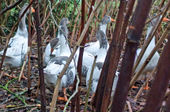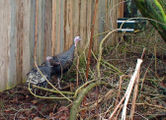|
|
| Line 1: |
Line 1: |
| − | Topic in [[Gardening courses]] | + | : : ''Topic in [[Gardening courses]]. By [[User:John|John Eagles]].'' |
| | + | : ''This page is under construction.'' |
| | + | A mixed farm is one where both crops and animals are cultivated and where crops are grown at least partly at the service of the livestock. A typical mixed farm would be one in which various animals are held, such as cows, goats, pigs, poultry. The manure is used to fertilize the land where all kind of crops, grass, rye, wheat, turnips, legumes, etc. are grown. Many of these products were used for the family of the family but some would be sold at markets. |
| | | | |
| − | == Chunks of information ==
| + | Modern agriculture is more and more becoming a large-scale business in which one farmer only has a dairy farm or only grows a few crops. For dairy farms, mostly the only mixed element is that maize and grass silage are fed to the cattle. |
| − | "A mixed farm is a farm where both agriculture and animal husbandry takes place, but where agriculture is at the service of the livestock. Mixed companies came mainly in the Pleistocene of the Netherlands and Belgium, where the soil was relatively poor and sandy. The clay areas had especially agriculture and low-lying areas especially livestock. Well had some livestock farms (a pig, a few cows, a chicken litter), but that was mainly for personal use.
| |
| | | | |
| − | Originally it was mixed business carried on by small farmers who supported themselves mostly in their ( small farmers ), but in the course of the 20th century the mixed farms also produce for the market. The cooperative purchases of fertilizer and feed played an important role. In fact, it had already become modern enterprises.
| + | == Changing agriculture: from small family farms to large companies == |
| | + | -- Huge dairy farms with up to 40,000 cows |
| | | | |
| − | Among the fodder that were harvested were fodder , but also grain crops such as rye and oats , and stoppelgewassen as spurrey and turnips, and some legumes. In addition, there were meadows and of course there was hay and straw produced.
| + | == Self-sustenance and close relationship to nature == |
| | | | |
| − | The end
| |
| | | | |
| − | During the second half of the 20th century, agriculture became largely rationalized and scaling-up. The number of farms declined and the remaining companies went further and further specialization. The intensive livestock entered the scene and the food was increasingly invoked from around the world, including through the port of Rotterdam .
| |
| | | | |
| − | The process of specialization is still going on, it creates varkensfokbedrijven, porkers businesses, companies laying hens and broilers farms, dairy farms and beef farms. The minimum number of animals per farm is increasing while the number of farms correspondingly decreases. These companies operate almost independently of the soil and are almost identical to industrial companies, albeit that the means of production of living beings exist. In addition to ethical issues also implies dependence on nature only constraint, the risk of livestock diseases. Mixed company in this situation no longer, unless it was the cultivation of maize , which together with grass silage is fed to the cattle." --- from http://nl.wikipedia.org/wiki/Gemengd_bedrijf, tranlated by Google Translate
| |
| | == Gallery == | | == Gallery == |
| | | | |
- : Topic in Gardening courses. By John Eagles.
- This page is under construction.
A mixed farm is one where both crops and animals are cultivated and where crops are grown at least partly at the service of the livestock. A typical mixed farm would be one in which various animals are held, such as cows, goats, pigs, poultry. The manure is used to fertilize the land where all kind of crops, grass, rye, wheat, turnips, legumes, etc. are grown. Many of these products were used for the family of the family but some would be sold at markets.
Modern agriculture is more and more becoming a large-scale business in which one farmer only has a dairy farm or only grows a few crops. For dairy farms, mostly the only mixed element is that maize and grass silage are fed to the cattle.
Changing agriculture: from small family farms to large companies
-- Huge dairy farms with up to 40,000 cows
Self-sustenance and close relationship to nature
Gallery
Geese and other animals fit in method of mixed farming on a family farm.
See also
External links


